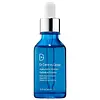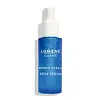What's inside
What's inside
 Key Ingredients
Key Ingredients

 Benefits
Benefits

 Concerns
Concerns

 Ingredients Side-by-side
Ingredients Side-by-side

Oenothera Biennis Flower/Leaf/Stem Extract
Skin ConditioningWater
Skin ConditioningGlycerin
HumectantSodium Hyaluronate
HumectantSaccharide Isomerate
HumectantYucca Aloifolia Leaf/Root Extract
MaskingLinoleic Acid
CleansingCentella Asiatica Extract
CleansingCucumis Sativus Fruit Extract
EmollientCeramide AP
Skin ConditioningCeramide EOP
Skin ConditioningCeramide NP
Skin ConditioningCitrullus Lanatus Fruit Extract
Skin ConditioningHydrolyzed Collagen
EmollientCamellia Sinensis Leaf Extract
AntimicrobialQuercetin Caprylate
AntioxidantGlycolic Acid
BufferingLactic Acid
BufferingChamomilla Recutita Flower Extract
MaskingGlycine Soja Extract
Skin ConditioningRetinol
Skin ConditioningTocopheryl Acetate
AntioxidantTocopherol
AntioxidantSymphytum Officinale Callus Culture Extract
Skin ConditioningCocos Nucifera Fruit Juice
EmollientTetrapeptide-21
Skin ConditioningCopper PCA
HumectantSodium PCA
HumectantUrea
BufferingBisabolol
MaskingLeuconostoc/Radish Root Ferment Filtrate
AntimicrobialLinolenic Acid
CleansingAcrylates/Carbamate Copolymer
Skin ConditioningC13-14 Isoparaffin
EmollientPhytosphingosine
Skin ConditioningZinc PCA
HumectantButylene Glycol
HumectantCaprylic/Capric Triglyceride
MaskingLaureth-7
EmulsifyingSodium Lauroyl Lactylate
EmulsifyingOctoxynol-9
EmulsifyingGlyceryl Oleate
EmollientIsosteareth-200 Linoleate
EmollientPolysorbate 20
EmulsifyingCarbomer
Emulsion StabilisingCholesterol
EmollientPolyacrylamide
Xanthan Gum
EmulsifyingSilica Dimethyl Silylate
EmollientBHT
AntioxidantDisodium EDTA
Citric Acid
BufferingSodium Citrate
BufferingPotassium Sorbate
PreservativePhenoxyethanol
PreservativeSodium Benzoate
MaskingBenzyl Salicylate
PerfumingLinalool
PerfumingParfum
MaskingOenothera Biennis Flower/Leaf/Stem Extract, Water, Glycerin, Sodium Hyaluronate, Saccharide Isomerate, Yucca Aloifolia Leaf/Root Extract, Linoleic Acid, Centella Asiatica Extract, Cucumis Sativus Fruit Extract, Ceramide AP, Ceramide EOP, Ceramide NP, Citrullus Lanatus Fruit Extract, Hydrolyzed Collagen, Camellia Sinensis Leaf Extract, Quercetin Caprylate, Glycolic Acid, Lactic Acid, Chamomilla Recutita Flower Extract, Glycine Soja Extract, Retinol, Tocopheryl Acetate, Tocopherol, Symphytum Officinale Callus Culture Extract, Cocos Nucifera Fruit Juice, Tetrapeptide-21, Copper PCA, Sodium PCA, Urea, Bisabolol, Leuconostoc/Radish Root Ferment Filtrate, Linolenic Acid, Acrylates/Carbamate Copolymer, C13-14 Isoparaffin, Phytosphingosine, Zinc PCA, Butylene Glycol, Caprylic/Capric Triglyceride, Laureth-7, Sodium Lauroyl Lactylate, Octoxynol-9, Glyceryl Oleate, Isosteareth-200 Linoleate, Polysorbate 20, Carbomer, Cholesterol, Polyacrylamide, Xanthan Gum, Silica Dimethyl Silylate, BHT, Disodium EDTA, Citric Acid, Sodium Citrate, Potassium Sorbate, Phenoxyethanol, Sodium Benzoate, Benzyl Salicylate, Linalool, Parfum
Water
Skin ConditioningButylene Glycol
HumectantPropanediol
SolventBetula Alba Juice
AstringentGlycerin
HumectantPhenoxyethanol
PreservativePEG-40 Hydrogenated Castor Oil
EmulsifyingSaccharide Isomerate
HumectantBetaine
HumectantXanthan Gum
EmulsifyingTrehalose
HumectantUrea
BufferingHydrolyzed Hyaluronic Acid
HumectantEthylhexylglycerin
Skin ConditioningSodium Hyaluronate
HumectantPentylene Glycol
Skin ConditioningDisodium EDTA
Caprylyl Glycol
EmollientSerine
MaskingMagnesium Aspartate
Skin ConditioningZinc Gluconate
Skin ConditioningSodium Hydroxide
BufferingPhenethyl Alcohol
MaskingCitric Acid
BufferingAlgin
MaskingDisodium Phosphate
BufferingGlyceryl Polyacrylate
Pullulan
Sodium Citrate
BufferingSodium Carrageenan
Emulsion StabilisingCopper Gluconate
Skin ConditioningGlucose
HumectantPotassium Phosphate
BufferingMaris Sal
Skin ConditioningChondrus Crispus Extract
Skin ConditioningLinalool
PerfumingParfum
MaskingWater, Butylene Glycol, Propanediol, Betula Alba Juice, Glycerin, Phenoxyethanol, PEG-40 Hydrogenated Castor Oil, Saccharide Isomerate, Betaine, Xanthan Gum, Trehalose, Urea, Hydrolyzed Hyaluronic Acid, Ethylhexylglycerin, Sodium Hyaluronate, Pentylene Glycol, Disodium EDTA, Caprylyl Glycol, Serine, Magnesium Aspartate, Zinc Gluconate, Sodium Hydroxide, Phenethyl Alcohol, Citric Acid, Algin, Disodium Phosphate, Glyceryl Polyacrylate, Pullulan, Sodium Citrate, Sodium Carrageenan, Copper Gluconate, Glucose, Potassium Phosphate, Maris Sal, Chondrus Crispus Extract, Linalool, Parfum
Ingredients Explained
These ingredients are found in both products.
Ingredients higher up in an ingredient list are typically present in a larger amount.
Butylene Glycol (or BG) is used within cosmetic products for a few different reasons:
Overall, Butylene Glycol is a safe and well-rounded ingredient that works well with other ingredients.
Though this ingredient works well with most skin types, some people with sensitive skin may experience a reaction such as allergic rashes, closed comedones, or itchiness.
Learn more about Butylene GlycolCitric Acid is an alpha hydroxy acid (AHA) naturally found in citrus fruits like oranges, lemons, and limes.
Like other AHAs, citric acid can exfoliate skin by breaking down the bonds that hold dead skin cells together. This helps reveal smoother and brighter skin underneath.
However, this exfoliating effect only happens at high concentrations (20%) which can be hard to find in cosmetic products.
Due to this, citric acid is usually included in small amounts as a pH adjuster. This helps keep products slightly more acidic and compatible with skin's natural pH.
In skincare formulas, citric acid can:
While it can provide some skin benefits, research shows lactic acid and glycolic acid are generally more effective and less irritating exfoliants.
Most citric acid used in skincare today is made by fermenting sugars (usually from molasses). This synthetic version is identical to the natural citrus form but easier to stabilize and use in formulations.
Read more about some other popular AHA's here:
Learn more about Citric AcidDisodium EDTA plays a role in making products more stable by aiding other preservatives.
It is a chelating agent, meaning it neutralizes metal ions that may be found in a product.
Disodium EDTA is a salt of edetic acid and is found to be safe in cosmetic ingredients.
Learn more about Disodium EDTAGlycerin is already naturally found in your skin. It helps moisturize and protect your skin.
A study from 2016 found glycerin to be more effective as a humectant than AHAs and hyaluronic acid.
As a humectant, it helps the skin stay hydrated by pulling moisture to your skin. The low molecular weight of glycerin allows it to pull moisture into the deeper layers of your skin.
Hydrated skin improves your skin barrier; Your skin barrier helps protect against irritants and bacteria.
Glycerin has also been found to have antimicrobial and antiviral properties. Due to these properties, glycerin is often used in wound and burn treatments.
In cosmetics, glycerin is usually derived from plants such as soybean or palm. However, it can also be sourced from animals, such as tallow or animal fat.
This ingredient is organic, colorless, odorless, and non-toxic.
Glycerin is the name for this ingredient in American English. British English uses Glycerol/Glycerine.
Learn more about GlycerinLinalool is a fragrance and helps add scent to products. It's derived from common plants such as cinnamon, mint, citrus, and lavender.
Like Limonene, this ingredient oxidizes when exposed to air. Oxidized linalool can cause allergies and skin sensitivity.
This ingredient has a scent that is floral, spicy tropical, and citrus-like.
Learn more about LinaloolParfum is a catch-all term for an ingredient or more that is used to give a scent to products.
Also called "fragrance", this ingredient can be a blend of hundreds of chemicals or plant oils. This means every product with "fragrance" or "parfum" in the ingredients list is a different mixture.
For instance, Habanolide is a proprietary trade name for a specific aroma chemical. When used as a fragrance ingredient in cosmetics, most aroma chemicals fall under the broad labeling category of “FRAGRANCE” or “PARFUM” according to EU and US regulations.
The term 'parfum' or 'fragrance' is not regulated in many countries. In many cases, it is up to the brand to define this term.
For instance, many brands choose to label themselves as "fragrance-free" because they are not using synthetic fragrances. However, their products may still contain ingredients such as essential oils that are considered a fragrance by INCI standards.
One example is Calendula flower extract. Calendula is an essential oil that still imparts a scent or 'fragrance'.
Depending on the blend, the ingredients in the mixture can cause allergies and sensitivities on the skin. Some ingredients that are known EU allergens include linalool and citronellol.
Parfum can also be used to mask or cover an unpleasant scent.
The bottom line is: not all fragrances/parfum/ingredients are created equally. If you are worried about fragrances, we recommend taking a closer look at an ingredient. And of course, we always recommend speaking with a professional.
Learn more about ParfumPhenoxyethanol is a preservative that has germicide, antimicrobial, and aromatic properties. Studies show that phenoxyethanol can prevent microbial growth. By itself, it has a scent that is similar to that of a rose.
It's often used in formulations along with Caprylyl Glycol to preserve the shelf life of products.
Saccharide Isomerate comes from sugars found in corn. It is a skin hydrator.
The structure of this ingredient can be altered to be more similar to the carbohydrates found in our skin. This ability to mimic our skin gives it hydrating properties.
Specifically, saccharide Isomerate is a humectant. Humectants draw moisture from the air to our skin.
Research shows Saccharide Isomerate to be an effective moisturizer.
Learn more about Saccharide IsomerateSodium Citrate is the sodium salts of citric acid. In skincare, it is used to alter pH levels and acts as a preservative.
Its main functions are to maintain the pH of a product and neutralize metal ions.
The acidity of our skin is maintained by our glands and skin biome; normal pH level of skin is slightly acidic (~4.75-5.5).
Being slightly acidic allows our skin to create an "acid mantle". This acid mantle is a thin barrier that protects our skin from bacteria and contaminants.
Learn more about Sodium CitrateSodium Hyaluronate is hyaluronic acid's salt form. It is commonly derived from the sodium salt of hyaluronic acid.
Like hyaluronic acid, it is great at holding water and acts as a humectant. This makes it a great skin hydrating ingredient.
Sodium Hyaluronate is naturally occurring in our bodies and is mostly found in eye fluid and joints.
These are some other common types of Hyaluronic Acid:
Learn more about Sodium HyaluronateUrea is also called carbamide and is the diamide of carbonic acid. In cosmetics, urea is used to hydrate the skin. It also provides exfoliation in higher concentrations.
As a humectant, urea helps draw moisture from the air and from deep within the skin. This helps hydrate your skin. Studies show urea is an effective moisturizer for dry skin conditions. 40% urea is typical in medications for treating eczema and other skin conditions.
Urea has the strongest exfoliation effect in concentrations higher than 10%. It is a keratolytic agent, meaning it breaks down the keratin protein in the top layer of skin. This helps remove dead skin cells and flaking skin.
In medicine, urea has been shown to help increase the potency of other ingredients, such as fungal treatments.
Humans and animals use urea to metabolize nitrogen-containing compounds. Urea is highly soluble in water. Once dissolved, it is neither acidic nor alkaline.
Learn more about UreaWater. It's the most common cosmetic ingredient of all. You'll usually see it at the top of ingredient lists, meaning that it makes up the largest part of the product.
So why is it so popular? Water most often acts as a solvent - this means that it helps dissolve other ingredients into the formulation.
You'll also recognize water as that liquid we all need to stay alive. If you see this, drink a glass of water. Stay hydrated!
Learn more about WaterXanthan gum is used as a stabilizer and thickener within cosmetic products. It helps give products a sticky, thick feeling - preventing them from being too runny.
On the technical side of things, xanthan gum is a polysaccharide - a combination consisting of multiple sugar molecules bonded together.
Xanthan gum is a pretty common and great ingredient. It is a natural, non-toxic, non-irritating ingredient that is also commonly used in food products.
Learn more about Xanthan Gum